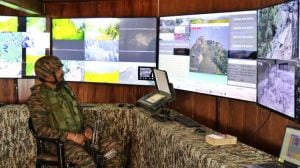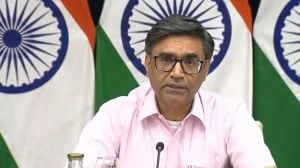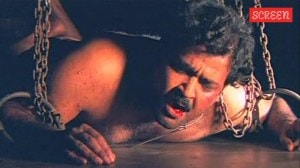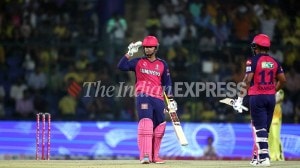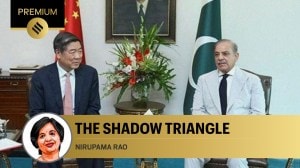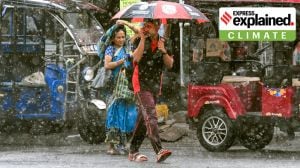UPSC Key: BrahMos missile, US-China Geneva talks, and India-Pakistan ceasefire declaration
How are the US-China Geneva talks relevant to the UPSC exam? What significance do topics like the India-Pakistan ceasefire, BrahMos missile, and caste census have for both the preliminary and main exams? You can learn more by reading the Indian Express UPSC Key for May 11, 2025.
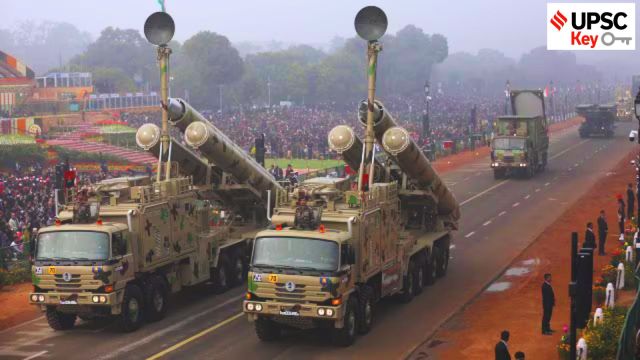 A Brahmos missile system being displayed at the Republic Day Parade in New Delhi. Know more in our UPSC Key. (Express Archives: Tashi Tobgyal)
A Brahmos missile system being displayed at the Republic Day Parade in New Delhi. Know more in our UPSC Key. (Express Archives: Tashi Tobgyal)Important topics and their relevance in UPSC CSE exam for May 11, 2025. If you missed the May 10, 2025, UPSC CSE exam key from the Indian Express, read it here.
FRONT PAGE
What has changed: India’s terms of engagement on terror and ties
Syllabus:
Preliminary Examination: Current events of national and international importance.
Main Examination: General Studies-II, III: India and its neighbourhood- relations. Role of external state and non-state actors in creating challenges to internal security. Security challenges and their management in border areas – linkages of organized crime with terrorism.
What’s the ongoing story: C. Raja Mohan writes- “Yet another military confrontation between India and Pakistan has come to an end and this time, after their most intense fighting in two decades, the terms of engagement between Delhi and Rawalpindi have changed.”
Key Points to Ponder:
• What was the 5-Point Action Plan Announced by India After the Pahalgam Terror Attack?
• What is the Line of Control? What are the security challenges faced by India on the LoC?
• What is the Indus Waters Treaty (IWT)?
• Read about Operation Sindoor and other past military operations by India against Pakistan.
• What is the ceasefire agreement between India and Pakistan? What do violations of ceasefire in times of crises indicate?
• How India’s approach towards Pakistan has evolved in the context of cross-border terrorism?
• How can India effectively use its global partnerships and public diplomacy to address the challenges posed by Pakistan?
• What measures has India taken to address the challenge of terrorism?
• Compare and contrast the defense capabilities of India and Pakistan in 2025.
• Map work: Indian states Bordering Pakistan (Refer Atlas)
Key Takeaways:
• “Since it came to power in 2014, the Modi government has sought to alter the traditional terms of engagement with Pakistan shaped by its nuclear weapons and its pursuit of cross-border terror with impunity.”
• “In the crisis that followed Pakistan’s terror attack on Uri in 2016, Delhi signalled that the Line of Control was no longer sacrosanct and it would be ready to cross it to attack the terror infrastructure in Pakistan-occupied Kashmir.”
• “In the current crisis, Delhi reached deep into the Panjab to hit at terror camps there. Delhi, the government is saying, will no longer hold back in countering the sources of terror. One of the key outcomes of the present crisis is the decision to suspend the Indus Waters Treaty.”
• “US Secretary of State Marco Rubio claimed Saturday that both sides agreed to talk on a “broad set of issues,” at a “neutral site.” Delhi, however, would wait to see whether the Pakistan army is sincere about implementing the ceasefire agreement.”
• “Another change in the structure of engagement with Pakistan is the role of third parties. The series of India-Pak military conflicts starting with the one that followed Operation Brass Tacks in the winter of 1986-87 through the Kargil war in 1999 and the Balakot strike in 2019 to the current confrontation following the Pahalgam massacre by Pak-backed terrorists all have several distinct features. One is common to all: the international involvement in conflict termination.”
• “This was driven by the fact that Pakistan had acquired nuclear weapons in the late 1980s and India followed soon after. The fear that an India-Pakistan military conflict could escalate into a nuclear exchange has long animated US policy in South Asia and defined the hyphenation.”
• “Even as the traditional big powers swooped in to separate India and Pakistan, Delhi and Rawalpindi have, over the years, shown the capacity to negotiate agreements between themselves.”
• “The crisis has also underlined the urgent need for accelerated defence reform that can generate a decisive edge for the Indian armed forces over Pakistan’s military. Operational military superiority is critical for the government if it wants to make good the promise made today to treat any terror attack originating in Pakistan as “an act of war”.
• “For India, changing the terms of engagement with Pakistan would necessarily involve developing serious outreach to diverse elements of the Pakistani polity and society. That will also help it decide how to climb the steps up the escalatory ladder the next time around.”
• “The people of India and Pakistan have seen the horrible face of the modern war of drones and long-distance fire. Unlike the Kargil and Galwan conflicts that took place in remote Himalayas, India’s cities have felt the heat of war after long. This will hopefully create better appreciation of the dangers of war and deeper introspection on the tragic state of bilateral relations eight decades after independence.”
Do You Know:
• Operation Sindoor: India launched ‘Operation Sindoor’ in the wee hours of Wednesday, hitting nine terror locations in Pakistan and Pakistan-occupied Kashmir (PoK). This marked the most expansive and widespread retaliation by India in recent years, since the Balakot airstrikes in 2019 and the surgical strikes following the Uri attack in 2016. The attacks were made at nine locations, which were terrorist infrastructure in Pakistan and Pakistan-occupied Kashmir.
• Operation Riddle (1965 Indo-Pak War): Operation Riddle was the Indian military’s response to the offensive launched by Pakistan under the code names of Operation Gibraltar and Grand Slam in 1965. As Pakistan violated the Line of Control (LoC) and entered Jammu and Kashmir, India launched this operation, targeting Lahore and Kasur on September 6, 1965. The operation had a crippling effect on the Pakistan military.
• Operation Ablaze (1965 Indo-Pak War): Operation Ablaze, too, was in the context of the 1965 Indo-Pak war. Launched as a defensive strategy on the western border, Operation Ablaze was the Indian Army’s pre-emptive mobilisation plan in April 1965, following rising tensions and skirmishes along the India-Pakistan border, particularly in the Rann of Kutch area.
—Although it did not immediately result in direct combat, this large-scale mobilisation demonstrated India’s readiness. The operation set the stage for heightened military preparedness before the full-fledged war broke out in August 1965.
• Operation Cactus Lily (1971 Indo-Pak War): Operation Cactus Lily, also known as The Meghna Heli Bridge or the Crossing of the Meghna, was an air assault operation conducted in December 1971 during the Bangladesh Liberation War. It was conducted by the Indian Army and Indian Air Force to cross the Meghna River, bypass a Pakistani stronghold at Ashuganj/Bhairab Bazar and reach Dhaka.
• Operation Vijay (1999 Kargil conflict): Operation Vijay was the codename for the Indian military operation launched in May 1999 to reclaim areas occupied by Pakistani forces during the Kargil War. The operation successfully forced Pakistani troops to withdraw and recapture critical positions, leading to India’s victory.
Other Important Articles Covering the same topic:
Previous year UPSC Prelims Question Covering similar theme:
(1) With reference to the Indus river system, of the following four rivers, three of them pour into one of them which joins the Indus directly. Among the following, which one is such a river that joins the Indus direct? (UPSC CSE 2021)
(a) Chenab
(b) Jhelum
(c) Ravi
(d) Sutlej
(2) Arrange the following agreements between India and Pakistan in chronological order:
1. Tashkent Declaration
2. Indus Water Treaty
3. Agreement on the Prohibition of Attack Against Each Other’s Nuclear Installations and Facilities
4. Agreement on Reducing the Risk from Accidents Relating to Nuclear Weapons
Select the correct answer using the code given below: (UPSC-CDS (II) – 2024)
(a) 1, 2, 3, 4
(b) 2, 3, 4, 1
(c) 2, 1, 3, 4
(d) 1, 4, 2, 3
Previous year UPSC Main Question Covering similar theme:
“Increasing cross-border terrorist attacks in India and growing interference in the internal affairs of several member-states by Pakistan are not conducive for the future of SAARC (South Asian Association for Regional Cooperation).” Explain with suitable examples. (UPSC CSE 2016)
BrahMos likely used in precision attacks on dozen Pak air bases
Syllabus:
Preliminary Examination: Current events of national and international importance.
Mains Examination: General Studies II, III: India and its neighbourhood- relations, Science and Technology
What’s the ongoing story: In retaliatory precision strikes on Pakistani military bases early Saturday, the Indian armed forces are learnt to have used the latest missiles, guided munitions and loitering munitions in their arsenal.
Key Points to Ponder:
• BrahMos supersonic cruise missile – Background and development
• What are the key features of the BrahMos supersonic cruise missile?
• What is the strategic significance of BrahMos?
• What are the different versions of BrahMos?
• The BrahMos missile is named after which two rivers?
• What are cruise missiles?
• Know the terms and differences between infrasonic, subsonic, supersonic, ultrasonic, etc.
• What do you understand by stealth technology?
• What are India’s important precision-guided long-range weapons and drones?
• What are the major defence agreements of India in the recent past?
• Read about the India-Russia defence cooperation.
Key Takeaways:
• It is learnt that air-launched precision weapons such as the HAMMER (Highly Agile Modular Munition Extended Range), an air-to-surface precision-guided munition, and the SCALP, an air-launched cruise missile, and the BrahMos supersonic cruise missiles were likely used in the attacks.
• The use of the BrahMos missile in the attack – there was no official word on it though – would mark the first-ever demonstration of the cruise missile in actual combat.
• Both the HAMMER precision-guided munition and the SCALP cruise missiles can be launched from the IAF’s Rafale fighters.
• The targets were chosen carefully, considering the Indian military’s decision to strike only identified Pakistani military targets, including technical infrastructure, command and control centres, radar sites and weapon storage areas.
Do You Know:
• Here are some of India’s important precision-guided long-range weapons and drones.
1. BRAHMOS: These supersonic cruise missiles, which have been operationalised in all three defence services, are built by BrahMos Aerospace, a joint venture between India’s Defence Research and Development Organisation (DRDO) and Russia’s NPO Mashinostroyeniya.
• BrahMos is a two-stage missile with a solid propellant booster engine. Its first stage brings the missile to supersonic speed (meaning faster than sound) and then gets separated. The liquid ramjet or the second stage then takes the missile closer to three times the speed of sound in cruise phase.
• The missile has an extremely low radar signature, making it stealthy, and it can follow a variety of paths. To hit the target, the ‘fire and forget’ missile can fly at a cruising height of 15 km and a terminal altitude of 10 m.
• BrahMos missiles operate at close to Mach 3 speed in the cruise phase, which ensures reduced flight time, lower dispersion of targets, and quicker engagement time and non-interception.
• The missile operates on a ‘Fire and Forget Principle’, adopting varieties of flights on its way to the target. As per its website, cruising altitude could be up to 15 km and terminal altitude as low as 10 metres. The missile carries a conventional warhead weighing 200-300 kg.
• The range of some BrahMos missiles for land and ship attacks have been nearly doubled in recent years.
2. HAMMER: The Highly Agile and Manoeuvrable Munition Extended Range (HAMMER) air-to-ground precision-guided weapon system for the Rafale fighter aircraft has a range of up to 70 km, and can also be fitted to bombs and various guided systems.
• Built by the French aerospace, defence, and security corporation Safran, the HAMMER weapon system is highly versatile, and can be used for precision strikes against a range of targets in medium-range tactical operations.
• According to the Safran Group, the system is autonomous and insensitive to jamming, and can be launched from a low altitude over rough terrain.
3. SCALP: This is an air-launched cruise missile with stealth features, designed for long-range deep strikes. SCALP-EG (Système de Croisière Autonome à Longue Portée — Emploi Général), known as Storm Shadow in Britain, can be operated at night and in all weather conditions.
• The missile, manufactured by the European multinational MBDA, has a range of 450 km, and is difficult to detect due to its low-flying capability when fired from an aircraft.
• Its advanced and highly accurate navigation system, which uses Inertial Navigation System (INS), Global Positioning System (GPS) and terrain referencing, can penetrate bunkers and ammunition stores.
4. METEOR: The Meteor is a new-generation Beyond Visual Range Air-to-Air Missile (BVRAAM) system which is effective in dense electronic-warfare environments.
Other Important Articles Covering the same topic:
📍BrahMos production unit in Lucknow set to be inaugurated today
UPSC Prelims Practice Question Covering similar theme:
(3) With reference to the BrahMos missile, consider the following statements:
1. It is a two-stage missile with a solid propellant booster engine.
2. The missile has a very low radar signature which makes it stealthy.
3. The course of the missile cannot be altered once fixed.
4. There is no sea to sea variant of BrahMos missile.
How many of the statements given above are correct?
(a) Only one
(b) Only two
(c) Only three
(d) All four
Trump claims credit; Delhi’s new red lines: terror from Pak ‘act of war’, Indus pause stays
Syllabus:
Preliminary Examination: Current events of national and international importance.
Main Examination: General Studies-II, III: India and its neighbourhood- relations, Effect of policies and politics of developed and developing countries on India’s interests, Role of external state and non-state actors in creating challenges to internal security. Security challenges and their management in border areas – linkages of organized crime with terrorism.
What’s the ongoing story: Eighteen days after a deadly terror attack in J&K’s Pahalgam prompted India to launch a military strike against Pakistan leading to four days of fierce confrontation, the two nuclear-armed countries agreed to stop firing and military action from 5 pm Saturday, marking an end to hostilities.
Key Points to Ponder:
• What is a ‘ceasefire’?
• What is the strategic and diplomatic significance of the recently announced ceasefire between India and Pakistan?
• What is the history of India-Pakistan ties?
• What is the Simla Agreement?
• How does the Simla Agreement shape India’s stance on external mediation in conflicts with Pakistan?
• Why does Pakistan keep violating the ceasefire with India?
• What does international law say about ‘breach’ of a ceasefire?
Key Takeaways:
• Announcing the ceasefire, Foreign Secretary Vikram Misri said at a media briefing Saturday evening, “The Director General of Military Operations (DGMO) of Pakistan called the Director General of Military Operations of India at 1535 hours IST earlier today. It was agreed between them that both sides would stop all firing and military action on land and in the air and sea with effect from 1700 hours Indian Standard Time today. Instructions have been given on both sides to give effect to the understanding.” The DGMOs will talk again at noon on May 12, he said.
• The United States, however, claimed credit for brokering the ceasefire. President Donald Trump said the two countries agreed on a full and immediate ceasefire “after a long night of talks mediated by the United States”.
• External Affairs Minister S Jaishankar framed the ceasefire as the working out of an “understanding” between India and Pakistan.
• Post the announcement, Jaishankar and National Security Advisor Ajit Doval spoke to ministers in key countries including China, Saudi Arabia and the European Union.
• Government sources in New Delhi said the decision to stop firing and military action was worked out “directly between the two countries”, and there was no “third party involvement”. India always insists that India and Pakistan resolve issues without any mediation by a third party — something that is set in the 1972 Simla agreement.
Do You Know:
• A ceasefire is an agreement between nations involved in a conflict that seeks to regulate the termination of all military activity “for a given length of time in a given area”, as defined by the book The Practical Guide to Humanitarian Law, by Françoise Bouchet-Saulnier.
• A ceasefire does not represent an end to hostilities. It represents a truce, that is, “a temporary suspension of hostilities,” in both international as well as non-international armed conflicts. They also “do not reflect a juridical end to the state of war,” as stated in the document.
•While there is no official definition of a ceasefire, Sydney D Bailey, an author and expert on international affairs, as quoted in an Oxford encyclopedia entry, describes it as “suspension of acts of violence by military and paramilitary forces, usually resulting from the intervention of a third party.” Ceasefires can either be formally documented, or agreed upon orally.
Other Important Articles Covering the same topic:
📍Ceasefire is the right decision. But India must stay vigilant about Pakistan’s next moves
📍Ceasefire is welcome, but it is also fragile
📍India-Pakistan ceasefire declaration: What exactly is a ‘ceasefire’
Previous year UPSC Mains Question Covering similar theme:
Terrorist activities and mutual distrust have clouded India – Pakistan relations. To what extent the use of soft power like sports and cultural exchanges could help generate goodwill between the two countries? Discuss with suitable examples. ( UPSC CSE 2015)
OPINION
Question of caste in free India: 1951 Census to now
Syllabus:
Preliminary Examination: Economic and Social Development-Sustainable Development, Poverty, Inclusion, Demographics, Social Sector Initiatives, etc.
Main Examination: General Studies II: Welfare schemes for vulnerable sections of the population by the Centre and States and the performance of these schemes; mechanisms, laws, institutions and Bodies constituted for the protection and betterment of these vulnerable sections.
What’s the ongoing story: Shyamlal Yadav writes- “On April 30 this year, the Cabinet Committee on Political Affairs (CCPA) approved caste enumeration in the forthcoming census.”
Key Points to Ponder:
• History of the census in India: Know in detail
• What kind of caste data is published in the census?
• What is a caste census? What is the history of caste census in India?
• Why was there a demand for conducting a caste census?
• What is the difference between a caste census and a socio-economic caste census (SECC)?
• What is the significance of a caste census? How will a caste census ensure social justice?
• Know the history of OBC reservation in India.
(Thought Process: Read about the Kaka Kalelkar Commission and Mandal Commission and their recommendations, 103rd Constitutional Amendment Act.)
• What are the advantages and disadvantages of a caste census?
Key Takeaways:
• “While India last collected caste data during the 1931 and 1941 Census, the latest available data is that of 1931 since the 1941 survey was not released. Similar data was collected during the 2011 Census too — but as a part of a special Socio Economic Caste Census (SECC) to identify households living below poverty line (BPL) as well as caste so that they could get various entitlements. Despite costing nearly Rs 5,000 crore, this countrywide report was never released.”
• “In a meeting of Census officials in February 1950, Deputy Prime Minister Sardar Vallabhbhai Patel, who also held the Home Affairs portfolio in the interim government headed by Pandit Jawaharlal Nehru, had announced categorically, “Formerly, there used to be elaborate caste tables which were required in India, partly, to satisfy the theory that it was a caste-ridden country and, partly, to meet the needs of administrative measures dependent upon caste division. In the forthcoming Census, this will no longer be a prominent feature.”
• “As soon as the 1951 Census was completed, the government in January 1953 decided to constitute a commission headed by then Rajya Sabha MP, social reformer and journalist Dattatreya Balkrishna Kalelkar, popularly called Kaka Kalelkar, to look after the demand for reservation and other affirmative actions for the other backward classes (OBCs). On March 18, 1953, then President Rajendra Prasad formally inaugurated the Kalelkar Commission.”
• “As the head of the First OBC Commission, Kalelkar’s biggest hurdle was the “lacunae” of caste data, especially of those who claimed to be OBCs. The Registrar General, meanwhile, provided the Commission with separate reports on the “estimated” population of certain OBC castes for different states.”
• “A report by the Kalelkar Commission noted that it had prepared a list of 2,399 castes as backward (Total population of the country in 1951 was 36.10 crore).
• “Advising that the next Census should “give all the necessary information about castes and sub castes”, the Kalelkar Commission said, “We would like to record here that the Census of 1961 should collect and tabulate all the essential figures caste-wise. We are also of the opinion that if it is possible, this should be carried out in 1957 instead of in 1961, in view of the importance of the problems affecting backward classes.”
• “Propagating for the caste census, the panel suggested, “It would certainly be valuable material for sociologists and anthropologists… But a lurking suspicion is asserting itself in my mind: Can we do it?”
• “Though the report of the First OBC Commission, submitted in 1955, was never implemented, its suspicions would prove to be true. There was no caste census till 2011, which was just an SECC exercise and not a part of the 2011 Census.”
• “By 1977, the demand to implement the Kalelkar Commission report had gathered steam. The Morarji Desai government then constituted the Second OBC Commission, headed by Bindheshwari Prasad Mandal, the scion of the erstwhile Murho Estate in Bihar who also served as the seventh chief minister of the state.”
• “The Mandal Commission’s report was submitted after Indira Gandhi stormed back to power in 1980. Its report, which too suggested a caste census, was implemented in parts in 1994 and then in 2009. Its suggestion on the caste census is finally expected to take place now.”
Do You Know:
• The data collected in Censuses since 1951 include the numbers of individuals belonging to the Scheduled Castes (SCs) and Scheduled Tribes (STs), and of various religious denominations. But the members of caste groups other than SCs and STs have not been counted.
• The most recent caste data available is from the Census of 1931. The 1941 Census, carried out during the War, collected data on caste, but they were never released.
• Ahead of the first Census of independent India, the government chose to avoid the question of caste. Thereafter, demands for a caste census were repeatedly raised, especially by parties who had a base among Other Backward Classes (OBCs), primarily farming communities and artisans.
• SECC is a study of socio economic status of rural and urban households and allows ranking of households based on predefined parameters.
Other Important Articles Covering the same topic:
📍Explained: Demands for a caste census, and what happens now after its approval
📍Caste Census: Legal basis, preparation timeline, and challenges ahead
Previous year UPSC Prelims Question Covering similar theme:
(4) Consider the following statements: ( UPSC CSE 2009)
1. Between Census 1951 and Census 2001, the density of the population of India has increased more than three times.
2. Between Census 1951 and Census 2001, the annual growth rate (exponential) of the population of India has doubled.
Which of the statements given above is/are correct?
(a) 1 only
(b) 2 only
(c) Both 1 and 2
(d) Neither 1 nor 2
(5) Which of the following articles of the Constitution of India provides for promotion of educational and economic interests of Scheduled Castes, Scheduled Tribes and other weaker sections?
(a) Article 45
(b) Article 47
(c) Article 48
(d) Article 46
ECONOMY
US, China trade talks: What could their likely deal mean for the world, India?
Syllabus:
Preliminary Examination: Current events of national and international importance, Economic Development.
Main Examination: General Studies II: Effect of policies and politics of developed and developing countries on India’s interests.
What’s the ongoing story: Negotiators from the US and China are set to begin talks on Saturday in Geneva, potentially paving the way for a trade deal, after the US President stated that “80 per cent tariffs on China seem right” amid early signs of easing trade tensions between the world’s two largest economies.
Key Points to Ponder:
• What are tariffs?
• US-China tariff war— Know in detail.
• What are India’s major exports to the U.S. and China?
• What does India import from the US and China?
• What can be the implications of a potential US–China trade deal on India’s economic interests?
• How has the US-China tariff war created opportunities for India?
• What are the various challenges that limit India from fully capitalising on the gains of the US-China trade war?
• “From a geo-economic perspective, anything that’s bad for China is good for India.” Evaluate this statement.
• Read about the bilateral trade agreement between India and the USA?
Key Takeaways:
• This comes as trade tensions between the two countries had started benefiting India, as US buyers began turning to Indian suppliers following the imposition of 145 per cent tariffs by the US on Chinese goods. These tensions have also improved India’s prospects for deeper economic integration with Western nations.
• However, a possible thaw in relations between the US and China could help Beijing regain lost ground, owing to its well-established technical capabilities — thereby reducing India’s chances of capitalising on this geo-strategic opportunity, particularly amid multiple ongoing trade deal negotiations.
• A potential US–China trade deal could quickly help Chinese exporters recover, due to superior technical expertise China has built over the years. Indian manufacturers say the country is currently not equipped to meet US demand in several labour-intensive sectors, such as non-leather footwear.
• A US–China trade deal may not be in India’s interest, as emerging markets like India stand to gain from the disruption caused by the ongoing trade conflict.
• Richard Baldwin, Professor of International Economics at IMD Business School, told this paper that sustained high tariffs on China would benefit large emerging markets. “China was a big competitor before, and it has now been hobbled,” he said. However, he pointed out that the now-deferred reciprocal tariffs did not cover pharmaceuticals and electronics — two sectors where India could have gained significantly.
• “From a geo-economic perspective, anything that’s bad for China is good for India,” Baldwin added.
• Baldwin also remarked that a near-term thaw in US–China relations is unlikely, due to a bipartisan consensus in the US that views China as a national security threat.
Do You Know:
• Tariffs are taxes or duties imposed by a government on imported goods and services. Their objective is to make foreign products more expensive compared to domestically produced goods, thereby encouraging consumers to prefer local products. Tariffs also act as a protective measure for domestic industries against foreign competition. Additionally, they serve as a source of revenue for the government.
Other Important Articles Covering the same topic:
📍Trump suggests cutting China tariffs to 80% before key talks
📍Timeline: How US-China tariff war escalated ahead of crucial Geneva talks
📍UPSC Issue at a Glance | Tariff war: 4 Key Questions You Must Know for Prelims and Mains
Previous year UPSC Mains Question Covering similar theme:
What are the key areas of reform if the WTO has to survive in the present context of ‘Trade War’, especially keeping in mind the interest of India? (UPSC CSE 2018)
| ALSO IN NEWS | |
| Stuck in orbit for over half a century, Soviet-era spacecraft plunges to Earth | A Soviet-era spacecraft plunged to Earth on Saturday, more than a half-century after its failed launch to Venus. Its uncontrolled entry was confirmed by both the Russian Space Agency and European Union Space Surveillance and Tracking. The Russians indicated it came down over the Indian Ocean, but some experts were not so sure of the precise location. The European Space Agency’s space debris office also tracked the spacecraft’s doom after it failed to appear over a German radar station. |
| Prelims Answer Key |
| 1. (d) 2. (c) 3. (b) 4. (d) 5. (d) |
Subscribe to our UPSC newsletter. Stay updated with the latest UPSC articles by joining our Telegram channel – Indian Express UPSC Hub, and follow us on Instagram and X.
🚨 Click Here to read the UPSC Essentials magazine for April 2025. Share your views and suggestions in the comment box or at manas.srivastava@indianexpress.com 🚨
Must Read



Buzzing Now


May 21: Latest News
- 01
- 02
- 03
- 04
- 05




